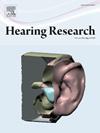宽频带生物声的耳蜗表征与神经振荡的出现
IF 2.5
2区 医学
Q1 AUDIOLOGY & SPEECH-LANGUAGE PATHOLOGY
引用次数: 0
摘要
回声定位的大棕蝠和瓶鼻海豚通过基带广播宽带超声回声定位呼叫来感知周围环境。尽管这些物种栖息在不同的介质中,发出的回声定位呼叫的频谱也不同,但它们都表现出相似的感知敏锐度:它们通过回声延迟确定目标范围,以微秒为单位检测回声延迟的变化,并感知超声波相位。这些感知能力过于敏锐,单凭单个神经元的反应无法理解,甚至神经群的反应也达不到所需的行为值。在此,我们提出了两种可能导致这些宽带回声定位器出现时间超敏锐性的机制。结构成像研究表明,在这两种动物中,耳蜗接收来自中耳的输入的位置与非回声定位哺乳动物不同。这些不寻常的输入模式可能会在沿基底膜的行波中产生干扰模式,进而通过产生低差频促进超声波相位的检测,而低差频可能会形成进一步神经处理的感知基底。第二种机制与在蝙蝠下丘观察到的诱发活动振荡有关,这可能会在神经层面产生广播回波干扰模式。由此产生的差频干扰信号对回声延迟和相位的变化非常敏感。因此,超声波的微小变化可能会通过放大回声时间本身,导致神经反应时序发生大得多的变化。本文章由计算机程序翻译,如有差异,请以英文原文为准。
Cochlear representation of wideband biosonar sounds and the emergence of neural oscillations
Echolocating big brown bats and bottlenose dolphins broadcast wideband ultrasonic echolocation calls in the baseband to sense their surroundings. Even though these species inhabit different media and emit echolocation calls with different spectra, both show similar perceptual acuity: They determine target range from echo delay, they detect changes in echo delay on a microsecond scale, and they perceive ultrasonic phase. These perceptual performances are too acute to understand on the basis of single neuron responses, and even neural population responses do not reach the required behavioral values. Here we propose two mechanisms that may contribute to temporal hyperacuity in these wideband echolocators. Structural imaging studies show that in both species the cochlea receives input from the middle ear at locations different from that seen in non-echolocating mammals. These unusual patterns of input might produce interference patterns in traveling waves along the basilar membrane, which in turn could facilitate detection of ultrasonic phase by producing low difference frequencies that may form a substrate for further neural processing into perception. The second mechanism is related to oscillations of evoked activity observed in the bat's inferior colliculus, which could create broadcast-echo interference patterns at the neural level. The resulting difference-frequency interference signals would be very sensitive to changes in echo delay and phase. Small changes in ultrasonic sounds thus could lead to much larger changes in neural response timing by magnifying echo time itself.
求助全文
通过发布文献求助,成功后即可免费获取论文全文。
去求助
来源期刊

Hearing Research
医学-耳鼻喉科学
CiteScore
5.30
自引率
14.30%
发文量
163
审稿时长
75 days
期刊介绍:
The aim of the journal is to provide a forum for papers concerned with basic peripheral and central auditory mechanisms. Emphasis is on experimental and clinical studies, but theoretical and methodological papers will also be considered. The journal publishes original research papers, review and mini- review articles, rapid communications, method/protocol and perspective articles.
Papers submitted should deal with auditory anatomy, physiology, psychophysics, imaging, modeling and behavioural studies in animals and humans, as well as hearing aids and cochlear implants. Papers dealing with the vestibular system are also considered for publication. Papers on comparative aspects of hearing and on effects of drugs and environmental contaminants on hearing function will also be considered. Clinical papers will be accepted when they contribute to the understanding of normal and pathological hearing functions.
 求助内容:
求助内容: 应助结果提醒方式:
应助结果提醒方式:


